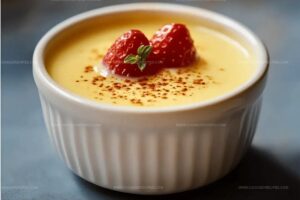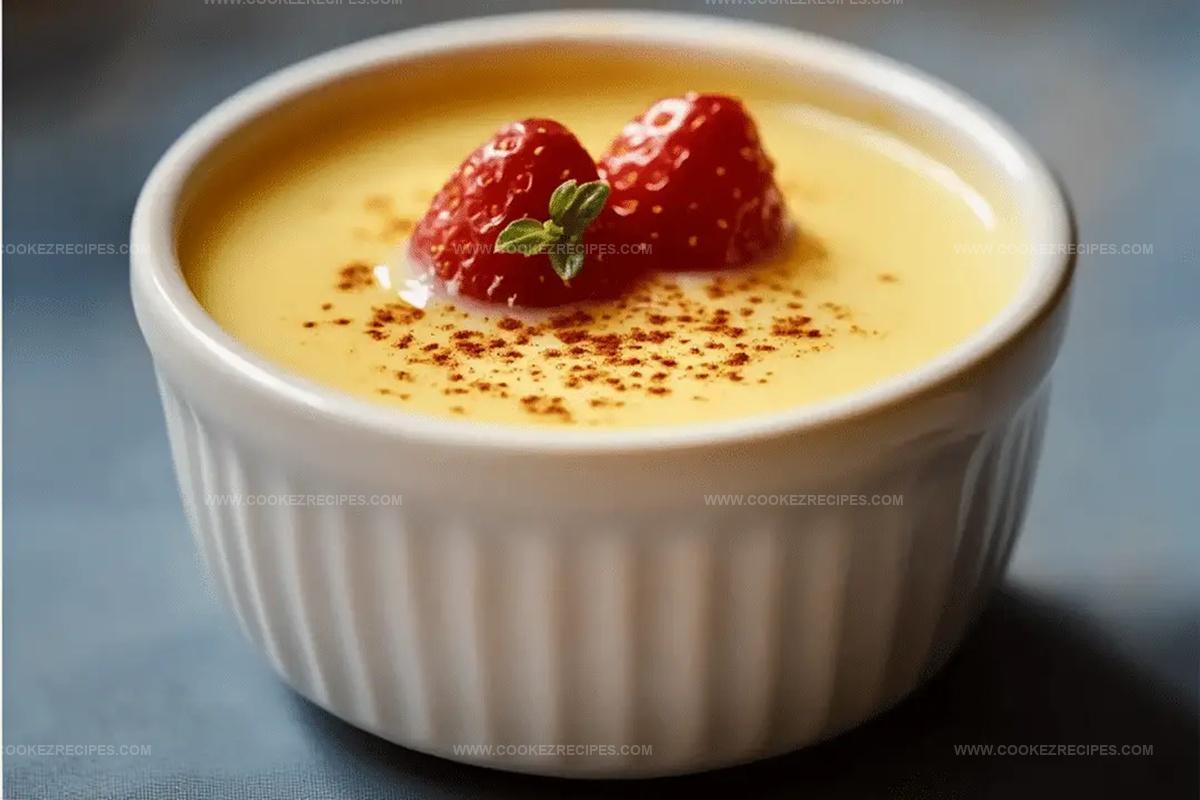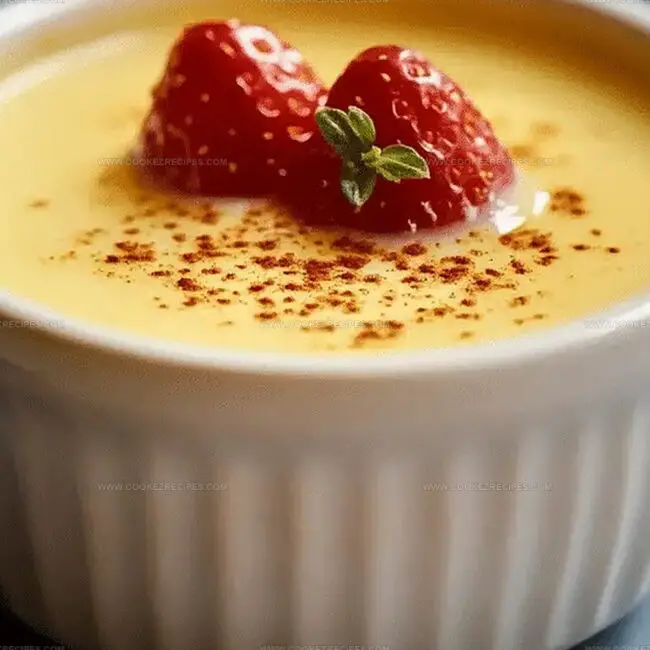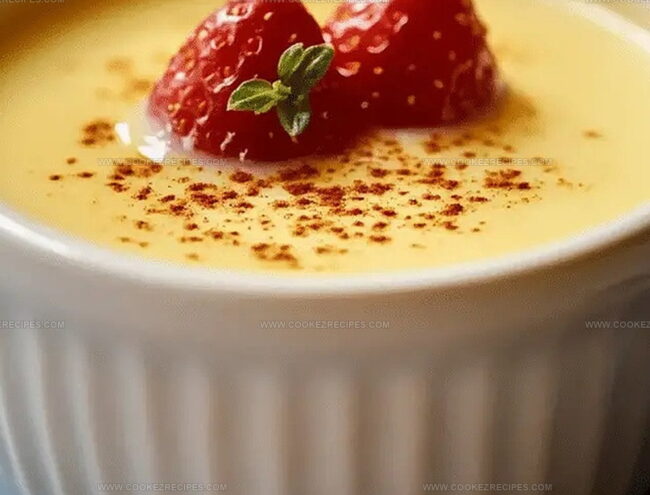The Silkiest Creamy Egg Custard Recipe for Sweet Comfort
Crafting a delightful egg custard brings pure comfort to any kitchen adventure.
Soft, silky textures promise a moment of pure culinary bliss.
My grandmother’s cherished recipe whispers generations of sweet memories.
Rich dairy and farm-fresh eggs combine in a dance of delicate flavors.
Smooth and luxurious, this classic dessert requires minimal ingredients but delivers maximum satisfaction.
Delicate whisking and gentle baking create a heavenly treat that melts on your tongue.
Custard Prep Tips For Creamy Egg Delight
How to Keep Creamy Egg Custard Smooth
Light Matches For Egg Custard
Smooth and Sweet Creamy Egg Custard Versions
FAQs
Insert a knife near the center of the custard. If it comes out clean with no liquid residue and the custard has a slight gentle jiggle, it’s perfectly done.
A water bath helps the custard cook evenly and prevents cracking by creating a gentle, consistent temperature around the dish, which protects the delicate egg mixture from direct heat.
Whole milk provides the best creamy texture, but you can use low-fat milk. Just keep in mind the custard might be slightly less rich and smooth compared to using full-fat milk.
Yes, small bubbles are normal during baking. They will typically settle and create a smooth surface as the custard cools. Avoid over-whisking to minimize excessive bubbling.
Creamy Egg Custard That Brings Old-Fashioned
Egg Custard Creamy Base Ingredients
Base Ingredients:Flavoring Ingredients:Preparation Ingredients:How To Make Creamy Egg Custard
Step 1: Warm Up The Oven
Get your oven ready by setting it to 350°F.
Grab an 8×8-inch baking dish and give it a light coating of cooking spray or butter to prevent sticking.
Step 2: Whisk Your Dream Mixture
In a spacious mixing bowl, combine your eggs, sugar, vanilla extract, and salt.
Whisk everything together until the mixture looks smooth and uniform, with no lumpy spots.
Step 3: Gently Heat Milk
Take a saucepan and warm your milk over medium heat.
You want it to reach about 180°F, but don’t let it boil.
Watch it carefully and remove from heat when it’s steamy and hot.
Step 4: Blend Milk and Egg Worlds
Slowly pour the warm milk into your egg mixture.
Whisk continuously to prevent the eggs from scrambling.
Keep whisking for an extra minute to ensure everything is perfectly combined.
Step 5: Prepare For Baking
Step 6: Create A Cozy Water Bath
Place your custard dish inside a larger pan.
Carefully pour hot water around the custard dish, filling it about one inch up the sides.
Be careful not to splash water into your custard.
Step 7: Bake To Perfection
Slide the pan into the oven and bake for 45-50 minutes.
Your custard is done when a knife inserted in the center comes out clean.
It should have a gentle wobble but not look liquid.
Step 8: Cool And Enjoy
Let the custard rest for 10-15 minutes after removing from the oven.
Serve it warm or chill in the refrigerator.
For extra indulgence, top with whipped cream or fresh berries.
Print
Creamy Egg Custard Recipe
- Total Time: 1 hour 5 minutes
- Yield: 6 1x
Description
Silky smooth creamy egg custard whispers comforting memories of grandma’s kitchen. Classic French dessert lovers will savor each spoonful of this delicate, rich pudding that melts effortlessly on your palate.
Ingredients
Main Ingredients:
- 4 cups 2% or whole milk
- 5 large eggs
Sweeteners and Flavorings:
- 1/2 cup sugar
- 1 1/2 teaspoons vanilla extract
Seasonings:
- 1/2 teaspoon salt
- Ground nutmeg for topping
Instructions
- Prepare the baking environment by heating the oven to 350°F and coating an 8×8-inch baking dish with a light layer of grease to prevent sticking.
- Craft a silky base by vigorously blending eggs, sugar, vanilla extract, and salt in a spacious mixing bowl until the mixture transforms into a uniform, glossy composition.
- Carefully warm the milk in a saucepan, monitoring the temperature until it reaches approximately 180°F, taking care to prevent boiling and scorching.
- Create a harmonious custard by slowly introducing the heated milk into the egg mixture, continuously whisking to prevent curdling and ensure a smooth, integrated texture.
- Transfer the lustrous custard into the prepared baking dish, then delicately dust the surface with a generous sprinkle of ground nutmeg for an aromatic enhancement.
- Establish a gentle water bath by positioning the custard dish within a larger pan, then carefully pouring hot water around the dish, ensuring it reaches one inch up the sides without infiltrating the custard.
- Bake the custard for 45–50 minutes, watching for a subtle jiggle and testing doneness by inserting a knife near the center—it should emerge clean, indicating perfect consistency.
- Allow the custard to rest and cool for 10–15 minutes after removing from the oven, then serve either warm or chilled, optionally garnishing with a dollop of whipped cream or fresh seasonal fruit for added elegance.
Notes
- Always use room temperature eggs to ensure smooth, even mixing and prevent curdling during the custard preparation.
- Create a silky texture by tempering the milk slowly into eggs, stirring constantly to distribute heat evenly and prevent scrambling.
- Position the water bath rack in the middle of the oven for consistent, gentle heat distribution that helps the custard cook uniformly without cracking.
- Customize the dessert by experimenting with flavor variations like adding cinnamon, lavender, or replacing vanilla with almond extract for unique taste profiles.
- Prep Time: 15 minutes
- Cook Time: 50 minutes (including roasting squash)
- Category: Desserts
- Method: Baking
- Cuisine: French
Nutrition
- Serving Size: 6
- Calories: 210
- Sugar: 10 g
- Sodium: 150 mg
- Fat: 10 g
- Saturated Fat: 5 g
- Unsaturated Fat: 4.5 g
- Trans Fat: 0 g
- Carbohydrates: 24 g
- Fiber: 0 g
- Protein: 8 g
- Cholesterol: 150 mg




Daniel Bruns
Founder & Culinary Innovator
Expertise
Recipe development for home cooks, Nutritional analysis and meal planning, Culinary education and food writing
Education
Auguste Escoffier School of Culinary Arts
Diploma in Culinary Arts and Operations
Focus: Classical and contemporary cooking techniques, Culinary entrepreneurship and kitchen management, Menu development and food cost analysis
Daniel’s story started with flour on his face and a pie in the oven at his grandma’s house. He later sharpened his skills at the Auguste Escoffier School of Culinary Arts.
His goal? Recipes so simple you’ll want to cook every night. When he’s not whipping up one-pan wonders, Daniel’s outside picking herbs, hosting neighborhood cook-offs, or baking chocolate cakes with his kids, messy, sweet, and unforgettable.